A Paipo Interview with Andy Bick
April 7 and 8, 2011 - Cornwall, England
E-mail interview by Bob Green
"This man felt the most supreme pleasure while he was driven so fast
and smoothly by the sea" - William Anderson, Tahiti 1777. Also
experienced today, 234 years later riding my poplar wood Paipo Glide at
Saunton - Pete Robinson.
|
1. When and where did you
start surfing?
1973 Takara - North Efate,Vanuatu (previously New Hebrides).
2. What boards were you riding in these early days?
These would have been long boards brought up from Australia by my
school friend's family. They owned a farm at Takara and their house was
set back about 100 yards from the beach. The reef was exposed at low
tide but we would start surfing as the tide came in taking care when we
fell off not to gash ourselves on the reef. The farm was close to Quoin
Hill which was an American airbase during WWII. There was an exposed
sandbank about 400 yards off the beach which must have been used as
target practice as we used to collect ammunition and shell cases off
the beach and reef.
At the beginning of 1974, a cyclone hit North Efate sending huge waves
crashing into the coast. At 2 o'clock in the morning I awoke to the
sound of breaking glass and a stream of water running through the
bedroom. Every seventh wave was surrounding the house. Suddenly the sea
crashed into the living room and I was waist deep in water. I remember
climbing onto a medicine shelf and looking down into this whirlpool
which was sweeping a large Chinese carved box round and round the room.
When the wave subsided we were evacuated to some farm buildings located
further inland. The next day the house was rubble and all the
belongings were now in a newly formed swamp behind the house. Strangely
the surfboards were unharmed and we used them to paddle around the
swamp collecting possessions.
3. Did you have exposure to paipo before returning to
the UK?
I suppose I might have had a zippy board.
When did you return to Cornwall?
The long hot summer of 1976 - I thought great - the weather here is not
so bad - how wrong I was! There has never been a summer like that one
since.
4. There is a long history of British bellyboarding. Was
this your inspiration for making wooden paipo or was there another
source?
No, it wasn't - although bellyboarding and surfing exploits by my
Perranporth family are well documented. My mother's aunt was a keen
bellyboarder in the 1930s - her husband used to make boards out of
coffin lids. Her uncle built a hollow wooden board in the early 1950s.
This was so heavy he had to use a little cart to wheel it down the
beach to the water - so maybe a switch in the genes! [See
Note 1.]
I couldn't consciously tell you how or why I decided to make boards - I
suppose I just got fed up with the sponge body boards. But I think the
confirmation provided by Rod, Larry, Roger and Chris (Haradza -
also known as Tumak and Logjammer) that I was not alone in wanting a performance prone vehicle
was my main inspiration.
How long had you been riding a bodyboard for and what
was your first paipo?
Bellyboards since the late-1970s. In the 1990s, I would borrow a bodyboard
occasionally (but the 1990s was all about scuba!) - didn't get the Morey
Wedge 'til around 2004/5.
A 30-year old
Piran bellyboard Andy rode from the late 1970s and his modern day
interpretation.
|
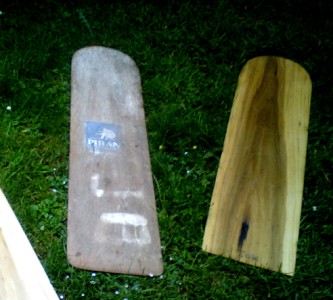
|
|
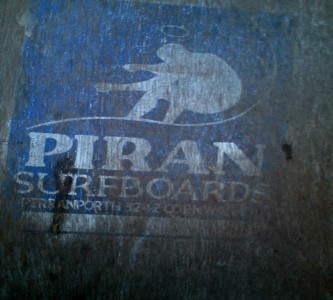
|
Photos courtesy Andy Bick
5. Had you made fibreglass boards before you moved to
wood?
No, although I have now had 2 bio-foam blanks prepared for me that I
have turned into Paipo Fishes. Foam is a different ball game than wood
though, fingernails are not an option. It makes you appreciate how
skilful the foam shapers are.
Andy's first
board 'Nambawan' and biofoam blank.
|
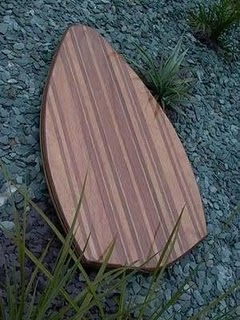
|
|
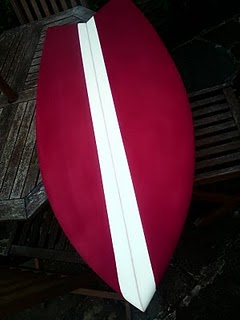
|
Photos http://paipoglide.blogspot.com/
6. When did you start making wooden boards?
2004.
Was this an idea that you had in your head for a while
or less planned than that?
It's hard to say. I had done very little surfing in the nineties as I
was completely tied up with scuba diving. I had given up teaching but
still needed to get into the sea. I had always taken out the belly
board with fins but found myself buying a Morey Wedge. After one
particularly gnarly session at Fistral in April cold white water,
infuriated that I couldn't duck dive, or get where I wanted to be, I
decided I would either give it up or do something about it. I think I
searched for fibre glass bodyboards and found Larry's, Rod's and Roger
Wayland's sites and discovered paipo! I cannot say I consciously
decided to make paipos - the concept must have come in a dream or
day-dream or something - I had no money to buy/commission one (had
already spent my allowance on a $200 Morey!!) so the logical step was
to make one.
The local boat building college had axed its surfboard building course
so looking on Swaylocks for a step by step guide I discovered Paul
Jensen.
7. How long does it take to make one of your boards?
The hollow one is easily 40 hours plus - but I don't work fast. A
bellyboard takes about 2 but then there's the time taken to rub in
several coats of oil and fine sanding
What is the construction method and what woods do you
prefer?
The hollow boards consist of a sandwich laminate of wood and glass
skins over an airplane wing like construction (well documented now on
the web). I put a certain amount of tension into the boards when I
epoxy the skin to the skeleton and once the rails have been laid you
have a very strong board. I make finless paipos as well as the finned
paipo fish. The fish is the fastest board!
Paipo Glide
Fish.
|
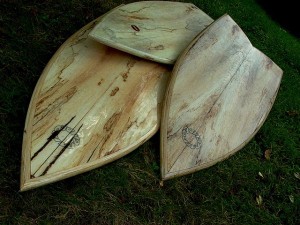
|
|
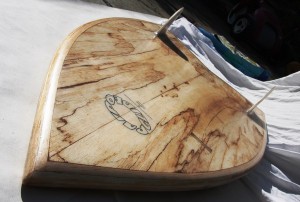
|
Andy's description: The hollow paipos are laminated ply or balsa and are positively
buoyant. The designs are based on my interpretation
of what a bodyboard should be, and ride beautifully. The twin fin fish
performs exceptionally.
Board dimensions: 47 x 20.5 x 1.5 inches. Above all, these boards are the definition of
fun and look great, too! |
Photos by Andy Bick.
I have used 4mm ply and balsa for the hollow paipos. I have been
fortunate enough to have been supplied with balsa that has been grown
at the Eden Project here in Cornwall. I find it incredible that I have
been making surfboards from wood grown in a greenhouse. I love shaping
balsa, but again, the fingernails get in the way.
For the bellyboards I have been used jelutong, paulownias and tulip
wood (American Poplar) from local timber merchants. I have to say I
prefer the densities of the jelutong and tulipwood over the paulownias
which I find is almost too light.
8. Has there been much evolution and design from the
first board?
An incredible amount of evolution! I was so proud of that first board
and posted it on Larry's site. It worked though and it was such a vibe
to ride a board that I'd built. Very heavy, wide and thick though. And
very spinny!! Wood boards don't need to have the same thickness as the
standard bodyboard so subsequent boards are a lot lighter and thinner
If so, in what ways?
The latest boards do differ from the first ones - at the time I was so
proud of them. The shapes are much more refined. I still surf them
though. The older boards were much thicker, wider heavier. I also went
through a phase of bending a lot of rocker into the boards - the rocker
is a bit more subtle now. I continue to play with bottom concaves and
my latest development has been fins.
Heading out with wood underarm.
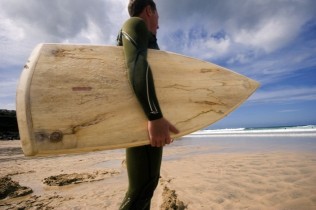
Photo by Andy Bick.
Any new designs on the drawing board?
I am really into the paipo fish so will be going along that angle and
exploring fin design as well.
My current obsession are the classic Cornish bellyboards. So I'm trying
to fashion the perfect bellyboard within the limitations of being 4 to 5
foot x 1 foot. I'll take these boards out back wearing fins in 5 to 6 foot surf
and get strange looks from the stand-up guys. but these boards are so
much fun! These are nice and quick to make, too, rather than the 40+ hour
odyssey it takes to build the hollow paipos.
Modern
interpretation of an old design: "I started making solid paipos/alaias
as prizes for the bellyboarding championships in 2009."
|
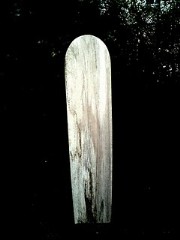
|
|
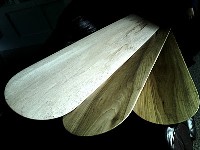
|
Photos by Andy Bick.
For Rod's benefit, I am also thinking about the pointy noses although it
is bloody hard to make a balsa rail bend beyond a certain radius and
I'm not a fan of nose/tail blocks
.
9. What are your thoughts on what does and doesn't work
on a paipo?
My 6-foot hollow alaia is a bit of a pig!
Other than that most of my designs tend to work for some reason. I am
not an engineer and although I'm fascinated by quantum physics it
doesn't come into play with my board design. If truth be told one of
the inspirations (along with sharks) are Sung Dynasty bowls (which have
never been emulated). I am a firm believer in if it looks right it
probably is right. When you look at a Spitfire you instinctively know
it's going to go. And it's strange to see the solid boards becoming
more and more like the ancient Hawaiian designs. I think it is
presumptuous of us today to believe that we are making better boards
than they used to. If I can ever add anything to those ancient shapes
it will be a miracle - but a pleasure!
P.S. Sharp noses are good for duck diving - we have a lot of beach
breaks here.
Sharp nosed
solid paipo
|
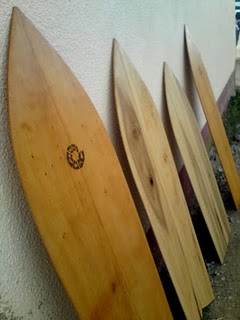
|
|
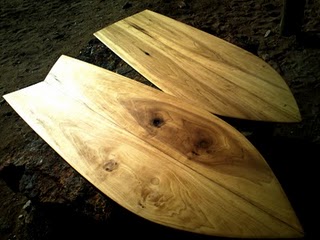
|
Photo courtesy Andy Bick.
10. What do you mean by the wooden boards making a
"wonderful sound" when they are surfed?
The boards are hollow and tensioned and therefore like a guitar or drum
make a great noise when hit by the water and waves.
11. Who has been buying your boards - local surfers,
collectors?
Both.
Who are some of the guys who ride your boards well and
what sort of waves are your boards ideally suited to?
?
John Navin, Martin Yelland, Leigh Evans and Richard Smith.
Well we mainly get beach breaks here and the boards go well in those -
especially paddling out. Also fast enough to make next sections of the
wave.
I'd love to see a much better rider than me ride the waves in Hawaii -
I'm sure the boards would too!
John Nevin -
Cornwall
|
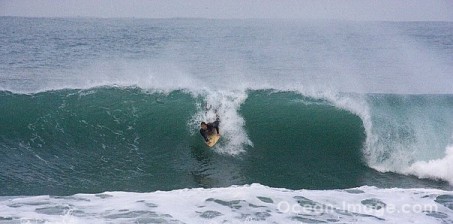
|
|
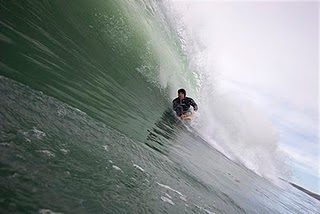
|
Photos by Mike Newman of Ocean-Image.com
12. Do you see many guys riding bellyboards or paipo in
Britain?
Paipos no. There is a big bellyboarding culture here as demonstrated by
the World Bellyboarding Championships which are fantastic. But I am
into prone boarding, but with fins, and for this country - wetsuits.
13. What is a Piran bellyboard?
Piran bellyboards were branded by Piran Surf. The shop still exists in
Perranporth - I don't know if they still do them - I'll try and find
out. Piran Surf was set up by John Heath and it used to be a hardware
store. Now John used to and still does surf quite a long bellyboard
which consists of 3 or 4 strips of wood not unlike an old wood crate
lid. He has even kept the square nose. John would be a mine of
information for you if you could contact him.
John Heath at left with a coffin lid and unidentified
surfing friend.
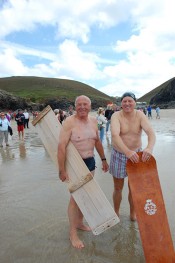
Photo by:
http://www.driftsurfing.eu/index.php/archives/3014#more-3014.
I'm interested to hear more about traditional British bellyboarding -
who build and ride the boards and where are they ridden?
I only stepped into bellyboards at the last World Championships when I
created 3 boards using the Piran surf board as a template. I did not
put in the nose lift as I feel it is superfluous - over the last 30
years the Piran surfboard has lost its lift and still performs well! I
personally don't hold with doing direct imitations but the boards did
provoke a lot of interest I suppose because of the familiar shape. So
I'm hoping they'll form a bridge of introduction to my more personal
performance related designs. Of course, I am enjoying using the classic
bellyboard proportions to push though my own take on the design. I'm
not contemplating nose lifts (this is sacrilegious to some) but I am
trying to give a purer shape to the nose. I also work on defining the
rail and started looking at tail options.
Jack Johns, a bodyboarder from Penzance, was crowned the 2010 bellyboard champion.
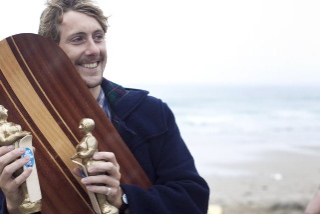
Above: Jack with his Original Surfboard Company board
which he rode in the championships. Also in the photo are
two trophies which he won. Photo by James Ram,
courtesy of Sally Parkin, Original
Surfboard Company.
Right: Andy Bick made two boards as prizes. The board
on the left is one of Andy's boards presented as a prize.
|
|
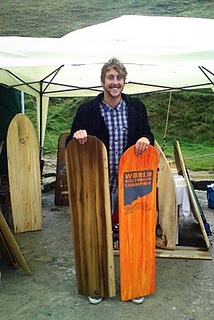
Photo courtesy of Andy Bick.
|
14. Many of the photos I have seen are of people in the
shallows catching small waves. I have heard of a technique where these
boards are swum out and then a swimming style stroke is used to catch
waves. Do you see this style around much?
Again the only guy I witnessed doing this is John Heath who will go out
of his depth and catches waves - without fins.
15. How do your boards differ from bellyboards in the
way they ride?
They are faster with more glide! I take bellyboards out using
fins (flippers) but find that in over 5 foot the board becomes a narrow bit
of wood! Surfable but you have to fight to control it more. But it may
just be my level of surfing. My solid paipos/alaias run between 4.5 to 5
foot and 16" at the widest point and it is a different ball game! Rail
to rail, tight turns, and making sections. There is so much more control. My
favourite is a 5-foot board that I cut a fish tail into -- this board
flies. It's like you think "I want to be there and the board just takes
you there."
16. Any surfs or waves stand out that you rode on your
boards?
I remember when I realised when I was onto something when I took my B3
design to Praa sands and caught a fairly clean right hander, bottom
turned and came back off the lip 3 or 4 times.
17. What has been the attraction of making and riding
paipo?
I didn't realise how satisfying it was to surf a board that you have
made - I think most surfers should have a go at least once - if only to
truly understand what an amazing piece of equipment their shaper
creates them for so little cost.
Modern solid bellyboards.
|
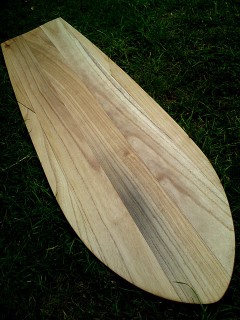
|
|
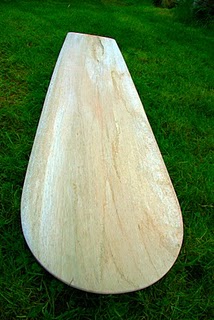
|
Photos by Andy Bick.
18. Any other comments?
I don't just see the surfboard as just a surfboard - I see it as a
sculptural piece. Obviously it is incredibly important that it
functions as a surfboard, and that it functions well as a surfboard,
but it also has to function as a work of art. At a physical level the
board is a tactile entity, visually, there is the interplay of form
with shape. Spiritually the board represents a metaphysical link to the
ancient Polynesian surfboard sculptor/craftsman and the ceremony, often
religious, involved in the creation of the board. It's also a protest
against the mass produced production line product. And the boards are
fun to ride!"
I have been thinking about handboards... :)
|
Note 1: : Andy's great Uncle was George Tamlyn
who along with William Saunders had met South African surfers while
serving in World War I. After the war bellyboards became popular at
Perranporth. Andy's grandparents, Olive (nee Westcott) and Roy Tamlyn
rode bellyboards in the 1930s, as did Olive's brother Arthur. Her
other brother, George married Roy's sister, Hilda, another
bellyboarder. Roy's other sister, Winnefrid (WIn) also rode a
bellyboard and married Tom Tremewan a local coffin maker who would go
on to build hundreds of wooden boards. For more information see:
Cornish boards in
the Perranzabulop Museum and Arthur Westcott's board
|
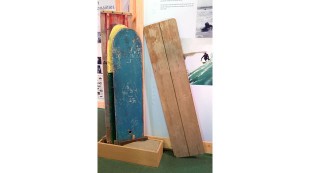
|
|
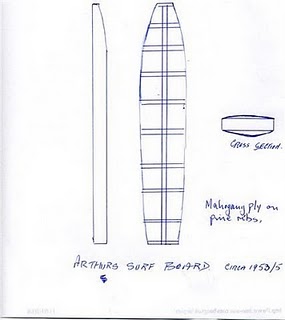
|
Photos courtesy of
Cornish surfboards - Perranzabulop Museum and Arthur's
surfboard.
|
|